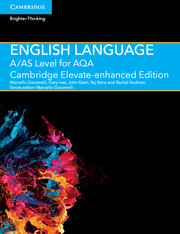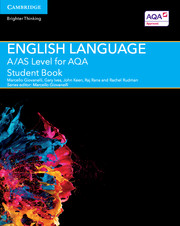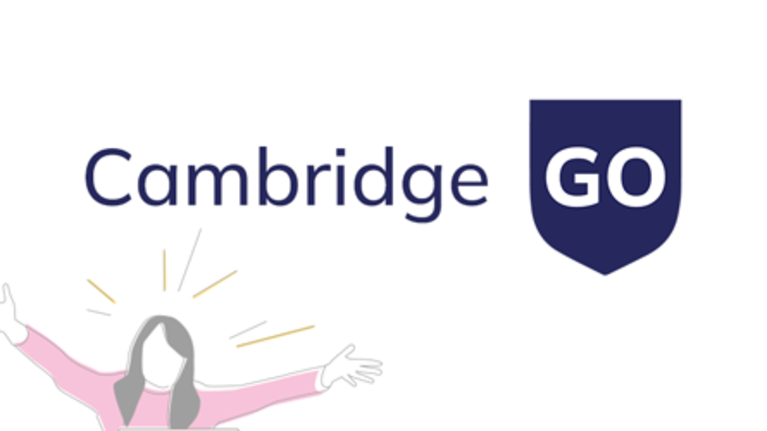A/AS Level English Language for AQA Digital Student Book (1 Year) School Site Licence
Overview
Written for the AQA A/AS Level English Language specifications for first teaching from 2015, this enhanced digital resource is suitable for all abilities. Helping bridge the gap between GCSE and A Level, the unique three-part structure provides essential knowledge and allows students to develop their skills through a deeper study of key topics whilst encouraging independent learning. Digital Editions include rich digital content such as video tutorials and extensive annotation tools. Available online and on tablet devices through the Cambridge Reader app.
Features
- A single one-year site licence for an unlimited number of teachers and students.
- The Digital Editions are fully customisable and interactive, with extensive annotation and bookmarking tools making texts more accessible for students.
- The Digital Editions feature rich digital content, including video tutorials covering key specification topics and interviews with writers and academics.
- The Digital Editions allow teacher–student messaging, helping you connect with your class in a timely and practical way.
- Available online and on tablet devices through the Cambridge Reader app.
- Suitable for all abilities, incorporating differentiated support and providing opportunities to stretch the more able and support those who need it.
- Unique three-part structure will help bridge the gap between GCSE and A Level, support students in developing their knowledge and skills, and prepare them for assessment, studies and life beyond A Level.
- Ideal for non-specialist teachers who may require additional support for the linguistic content.
- Supports both AS and A Level teaching of the new linear specification with AS content signposted throughout.
- Free Digital Teacher’s Resources with each Digital Edition allow for easy linking and cross reference, and provide comprehensive planning support with additional opportunities for differentiation and extension.
Contents
- Introduction
- BEGINNING:
- 1. What does language study mean at A Level?
- 2. Text producers and receivers
- 3. Mode and genre
- 4. Language use and language users
- 5. Language level 1: Lexis and semantics
- 6. Language level 2: Grammar
- 7. Language level 3: Phonetics, phonology and prosodics
- 8. Language level 4: Graphology
- 9. Language level 5: Pragmatics
- 10. Language level 6: Discourse
- 11. Introduction to analysing texts
- 12. Becoming a language investigator
- DEVELOPING:
- 13. Textual variations and representations
- 13.1 Textual variations
- 13.2 Language analysis: methods and approaches
- 13.3 Language analysis: genre and mode
- 13.4 Language analysis: audience and purpose
- 13.5 Introduction to representations
- 13.6 Language and representations: people, social groups and gender
- 13.7 Language and representations: events, places and issues
- 13.8 Exploring similarities and differences between texts
- 13.9 Bringing it all together
- 14. Child language development
- 14.1 Learning to talk
- 14.1.1 The process of spoken acquisition
- 14.1.2 A historical overview of acquisition theory
- 14.1.3 Environmental factors
- 14.1.4 Pragmatics
- 14.1.5 Discourse
- 14.1.6 Lexis and semantics
- 14.1.7 Grammar
- 14.2 Learning to write
- 14.2.1 Early exposure to printed language
- 14.2.2 Learning to read
- 14.2.3 The process of writing development
- 14.2.4 Attitudes and theories about learning to write
- 14.2.5 Environmental factors
- 14.2.6 Handwriting and orthography
- 14.2.7 Lexical and grammatical development
- 14.3 Bringing it all together
- 15. Language diversity
- 15.1 Varieties and diversity – an overview
- 15.2 Geographical varieties of English
- 15.3 Grammatical variations
- 15.4 Phonological variations: our accent
- 15.5 Personal and social varieties of English
- 15.6 Bringing it all together
- 16. Language change
- 16.1 Studying language change
- 16.2 The origins of English
- 16.3 Lexical change
- 16.4 Semantic change
- 16.5 Orthography
- 16.6 Grammatical change
- 16.7 Standardisation
- 16.8 Why does change happen?
- 16.9 How does change spread?
- 16.10 Bringing it all together
- 17. Language in action: a language investigation
- 17.1 What is a language investigation?
- 17.2 Choosing an area to investigate
- 17.3 What approach could you take?
- 17.4 Data collection
- 17.5 Data selection
- 17.6 Writing your investigation
- 17.7 Bringing it all together
- 18. Original writing
- 18.1 The writing process
- 18.2 The style model
- 18.3 The power of persuasion
- 18.4 The power of storytelling
- 18.5 The power of information
- 18.6 The drafting process
- 18.7 Writing a commentary
- 18.8 Referencing your work
- 18.9 Bringing it all together
- ENRICHING:
- 19 Textual variations and representations
- 20 Language development
- 21 Language diversity
- 22 Language change
- 23 Language investigation
- 24 Original writing
- References
- Index
- Acknowledgements
Brighter Thinking Blog
Keep up to date with the latest classroom tips and educational trends from our brighter thinkers.
Visit the blogCatalogues and Ordering
Looking for something in particular or just browsing? View our catalogues to see our full range of print and digital books.
View and downloadAdvice on useful tools
Advice on useful tools, activities and timetabling from teachers experiencing school closures.
Cambridge GO
All our supporting resources have now moved to Cambridge GO – the new home for your Cambridge digital content.
Listen to our podcast
Listen to our podcast to discover teaching inspiration & advice from leading educational thinkers.






